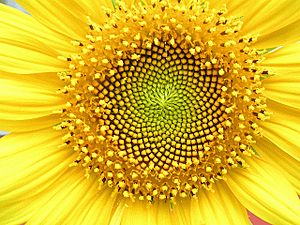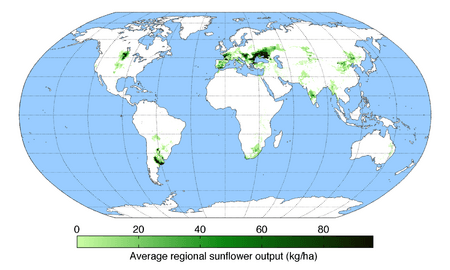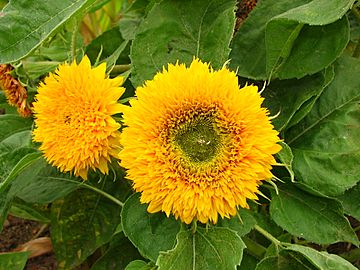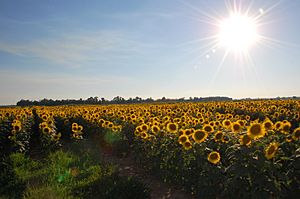Common sunflower facts for kids
Quick facts for kids Common sunflower |
|
|---|---|
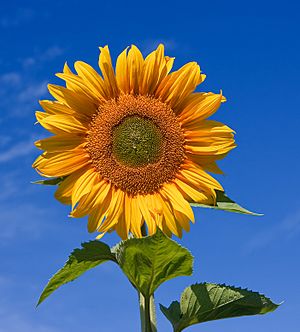 |
|
| Horticultural variety of common sunflower | |
| Conservation status | |
| Scientific classification | |
| Genus: |
Helianthus
|
| Species: |
annuus
|
| Synonyms | |
|
Synonymy
Helianthus aridus Rydb.
Helianthus erythrocarpus Bartl. Helianthus indicus L. Helianthus jaegeri Heiser Helianthus lenticularis Douglas Helianthus macrocarpus DC. & A.DC. Helianthus multiflorus Hook. Helianthus ovatus Lehm. Helianthus platycephalus Cass. Helianthus tubaeformis Nutt. |
|
The common sunflower (scientific name: Helianthus annuus) is a tall plant that lives for only one year. It is grown as a crop for its edible oil and edible fruits (which we call sunflower "seeds").
People use sunflowers for many things. They are a popular wild bird food and are also fed to livestock like cows. Sunflowers are also used in some industries and are grown in gardens because they look beautiful. This plant was first grown by people in the Americas. Wild sunflowers have many branches and lots of small flower heads. But the sunflowers we grow often have just one big flower head on a single stem. The name "sunflower" probably comes from its large, round head, which looks like the sun.
Sunflower seeds were brought to Europe from the Americas in the 1500s. There, both the seeds and sunflower oil became very popular for cooking.
Contents
What Does a Sunflower Look Like?
Sunflower plants have a straight, rough stem that can grow very tall, often up to 3 meters (about 10 feet). The tallest sunflower ever recorded was over 9 meters (about 30 feet) tall! Sunflower leaves are wide, rough, and have jagged edges. They usually grow one after another along the stem.
What we call the "flower" of a sunflower is actually a "flower head" made up of many tiny individual flowers called florets. The bright yellow "petals" on the outside are called ray flowers. Each "petal" is actually a small flower that is sterile, meaning it can't produce seeds. They can be yellow, red, orange, or other colors.
The tiny flowers in the center of the head are called disk flowers. These are the ones that turn into the sunflower "seeds" (which are actually fruits). The disk flowers are arranged in a cool spiral pattern. This pattern helps the sunflower pack as many seeds as possible into its head. If you look closely, you'll see spirals going in two directions. The number of spirals in each direction are usually Fibonacci numbers, like 34 and 55, or even 89 and 144 in very large sunflowers!
Most types of sunflowers we grow are varieties of Helianthus annuus. But there are other sunflower species too, like the Jerusalem artichoke (H. tuberosus), which grows edible tubers (like potatoes) underground.
Sunflower Genes
The sunflower has a genome (all its genetic information) that is quite large. It has 17 chromosomes, and its genome size is estimated to be around 3.5 billion base pairs. This is even a bit larger than the human genome!
How Sunflowers Are Grown and Used
Sunflowers need lots of sunshine to grow well. They prefer rich, moist soil that drains water easily. For farmers, sunflower seeds are usually planted about 45 centimeters (1.5 feet) apart and 2.5 centimeters (1 inch) deep.
Sunflower "seeds" (the whole fruit) are a popular snack. You can eat them raw or roasted, with or without salt. They can also be made into sunflower butter, which is like peanut butter. In Germany, sunflower seeds are mixed with rye flour to make a popular bread called Sonnenblumenkernbrot. Sunflowers are also sold as food for birds and can be used directly in cooking and salads.
Long ago, Native Americans used sunflowers in many ways. They made bread from them, used them in medicines, and even made dyes and body paints from the plants.
In countries in Eastern Europe, like Russia and Ukraine, a sweet treat called sunflower halva is very popular. It's made from sunflower seeds instead of sesame seeds.
Sunflower oil is pressed from the seeds. It's used for cooking, to make margarine, and even to produce biodiesel. Some types of sunflower oil are very healthy, with more good fats than even olive oil. The oil is also sometimes used to make soap.
After the oil is taken out of the seeds, the leftover part is called "cake." This cake is used to feed farm animals. The outer shells of the seeds can also be fed to animals.
Some newer types of sunflowers have heads that droop downwards. Gardeners might not like these as much, but farmers do! This is because drooping heads help protect the seeds from birds and some plant diseases. Scientists are also studying sunflowers to see if they can be used to make natural rubber for people who are allergic to regular rubber.
Historically, some Native American groups planted sunflowers on the north side of their gardens. They called it the "fourth sister" to their other main crops: corn, beans, and squash. Sunflowers can also help other plants grow by releasing chemicals that stop weeds.
However, for farmers who grow other crops like corn or soybeans, wild sunflowers can be a problem. They are considered a weed because they can reduce how much of the other crops grow.
Sunflowers can also help clean up polluted soil and water. This is called phytoremediation. They can pull out harmful things like lead, arsenic, and uranium from the soil. They were used to clean up radioactive materials after the Chernobyl disaster and the Fukushima Daiichi nuclear disaster.
Popular Sunflower Types
Sunflowers are grown in gardens because they are easy to grow and look amazing. They are a favorite for children to plant! There are many different types, or cultivars, of sunflowers available from seeds. They come in various sizes and colors. Some popular types include:
- American Giant
- Arnika
- Autumn Beauty
- Aztec Sun
- Black Oil
- Chianti Hybrid
- Claret agm
- Dwarf Sunspot
- Evening Sun
- Florenza
- Giant Primrose
- Gullick's Variety agm
- Incredible
- Indian Blanket Hybrid
- Irish Eyes
- Italian White
- Kong Hybrid
- Large Grey Stripe
- Lemon Queen agm
- Loddon Gold agm
- Mammoth Russian
- Miss Mellish agm
- Monarch agm
- Mongolian Giant
- Munchkin
- Orange Sun
- Pastiche agm
- Peach Passion
- Peredovik
- Prado Red
- Red Sun
- Ring of Fire
- Rostov
- Skyscraper
- Solar Eclipse
- Soraya
- Strawberry Blonde
- Sunny Hybrid
- Sunsation Yellow
- Sunshine
- Taiyo
- Tarahumara
- Teddy Bear agm
- Thousand Suns
- Titan
- Valentine agm
- Velvet Queen
- Yellow Disk
Do Sunflowers Follow the Sun?
Many people think that sunflower heads turn to follow the sun all day long. This is actually a common misunderstanding! While young sunflower buds do move to face the sun, mature, flowering sunflower heads usually point in a fixed direction, most often towards the east, all day long. This idea was even corrected way back in 1597 by an English botanist named John Gerard.
The reason all the sunflowers in a field might look like they are tracking the sun is because they are all facing the same way. This happens when they are young. Young sunflowers actually have a kind of internal clock, called a circadian rhythm, that tells them to turn towards the sun. In the morning, they face east. As the day goes on, they slowly turn west. Then, overnight, they turn back to face east again, ready for the morning sun. This internal clock keeps working even on cloudy days!
Once a sunflower plant is fully grown and its flower head is mature, it stops moving and stays facing east. This eastward direction helps the flower warm up quickly in the morning, which attracts more pollinators like bees.
History of Sunflowers
Sunflowers were one of the first plants grown by Native Americans in North America thousands of years ago. It was thought that sunflowers were first grown by people in the southeastern US around 5,000 years ago. However, there is now evidence that they might have been first grown in Mexico even earlier, around 2600 BC. The oldest known domesticated sunflower seeds in the United States were found in Tennessee and date back to about 2300 BC.
Many indigenous peoples used the sunflower as a symbol for their sun gods. This included the Aztecs and Otomi people in Mexico, and the Incas in South America. In 1510, early Spanish explorers saw sunflowers in the Americas and brought their seeds back to Europe.
In the 1700s, sunflower oil became very popular in Russia. This was especially true for members of the Russian Orthodox Church, because sunflower oil was one of the few oils allowed during Lent (a period of fasting). In the early 1800s, a merchant named Daniil Bokaryov from the village of Alexeyevka developed a way to extract the oil on a large scale. This made sunflower oil spread quickly. The town's symbol even includes a sunflower because of this!
Sunflowers in Culture
- The sunflower is the state flower of Kansas in the US. It is also one of the city flowers of Kitakyūshū, Japan.
- Sunflowers are often used as a symbol for environmental movements. The sunflower is also the symbol of The Vegan Society.
- In the late 1800s, the sunflower was a symbol of the Aesthetic Movement, which focused on beauty in art and design.
- The famous artist Vincent van Gogh painted a series of artworks called Sunflowers.
- The sunflower is the national flower of Ukraine.
- The sunflower was chosen as the symbol of the Spiritualist Church. They believed it turned towards the sun, just as "Spiritualism turns toward the light of truth." (As we learned earlier, mature sunflowers don't actually track the sun).
- The Incas also worshipped sunflowers because they saw them as a symbol of the Sun.
- The sunflower was the symbol for the Sunflower Movement, a large protest that happened in Taiwan in 2014.
Other Kinds of Sunflowers
There are many different types of plants in the Helianthus genus that are called sunflowers. There are also other plants that people call sunflowers, even if they are not closely related.
- The Maximillian sunflower (Helianthus maximiliani) is one of 38 types of sunflowers that live for many years (perennial) and are found in North America.
- The sunchoke, also known as the Jerusalem artichoke (Helianthus tuberosus), is another type of perennial sunflower.
- The Mexican sunflower (Tithonia rotundifolia) is only distantly related to the North American sunflowers.
- "False sunflower" refers to plants in the genus Heliopsis.
New Sunflower Types (Hybrids)
Today, most sunflower seeds grown by farmers are hybrids. Hybrid sunflowers are made by crossbreeding different types of sunflowers, for example, mixing cultivated sunflowers with wild ones. This creates new combinations of genes. These hybrid sunflowers are often stronger and have useful traits that farmers want, like being resistant to diseases.
What Harms Sunflowers?
Sunflowers can face threats from diseases. One major threat is Fusarium, a type of fungus found in soil and plants. It can cause a lot of damage to sunflower crops, sometimes destroying up to 80% of them.
Downy mildew is another disease that sunflowers can get. Sunflowers are especially likely to get this disease because their seeds are often planted only an inch deep in the ground. If the soil is wet, it increases the chances of diseases like downy mildew.
Another big threat to sunflowers is broomrape. This is a parasite that attacks the roots of the sunflower plant. It can cause huge damage, sometimes destroying 100% of the crop.
See also
 In Spanish: Girasol para niños
In Spanish: Girasol para niños



